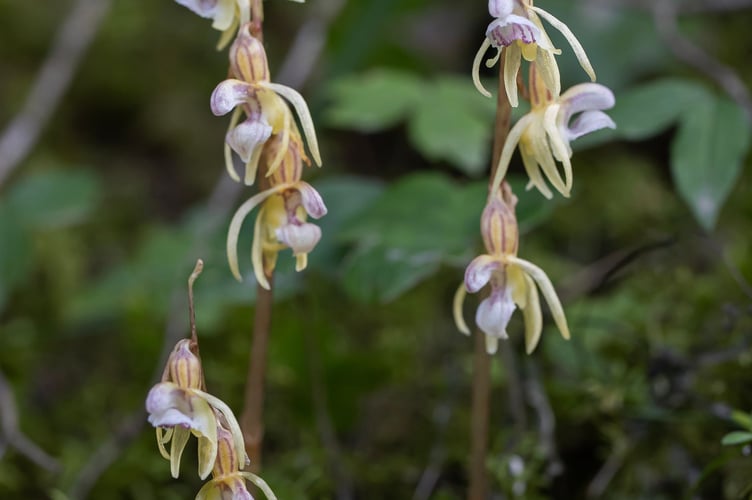A rare wild orchid first discovered in Herefordshire over 170 years ago and believed to be extinct in the UK has been rediscovered for the first time since 2009.
Britain’s rarest wild orchid - the Ghost Orchid - has been rediscovered in Britain for the first time for only the second time since the 1980s by Richard Bate, a dedicated member of the Botanical Society of Britain and Ireland (BSBI)1 and a keen amateur botanist since childhood. Richard's passion for botany began with an encounter with a Bee Orchid when he was just ten years old, inspiring him to spend 30 years searching British woodlands for the elusive Ghost Orchid. A dental surgeon by profession, in his free time Richard’s passion for finding wild orchids has carried him all over the world and, in recent years, has seen him leading orchid-hunting tours across Europe for Mariposa Nature Tours, a wildlife tour company that is a corporate supporter of BSBI’s conservation and research work.

Richard’s dedication and eye for detail were rewarded earlier this month when he found and photographed a single Ghost Orchid at a site in England. The find has been authenticated by the BSBI but the location is being kept secret to protect the delicate habitat and the sensitive underground parts of the orchid, which would be vulnerable to trampling by enthusiasts who visit sites annually in the hope of finding this uber-elusive orchid. Richard said “Knowing that the Ghost Orchid is still here and hasn’t gone extinct in Britain fills me with hope for the future of this species. I am deeply grateful to the BSBI for their unwavering support of botanists like me and for their dedication to studying, recording and conserving Britain's wild plants. This discovery reminds us that even in the darkest woods, there is always hope." The Ghost Orchid is named for its pallid ivory-white colour and its tendency to emerge in the deepest, darkest shade of woodland. Unlike most of our wild plants, it has no leaves and no chlorophyll, so it cannot photosynthesise. Instead, it relies entirely on nutrients from a subterranean fungal partner. Because it doesn’t need sunlight, the Ghost Orchid exists almost entirely underground, only appearing above the leaf litter on the rare occasions when the conditions are conducive to flowering. First recorded in Britain in Herefordshire in 1854, the Ghost Orchid's initial identification was remarkably late for a native species, probably due to its rare and unpredictable appearances. Over the next 170 years, it was recorded flowering in Britain only a few dozen times.
At a glance history of the Ghost Orchid in Britain
- Herefordshire and Shropshire: Found flowering in only five years between 1854 and 1910, followed by a 72-year gap until 1982, and then a 27-year gap until the last sighting in 2009.
- Oxfordshire: Discovered by a schoolgirl in 1924, the Ghost Orchid was found flowering in about a dozen years between 1924 and 1979.
- Buckinghamshire: First found in 1953, the Ghost Orchid was recorded in bloom in 25 of the years between 1953 and 1987.
In 2009, it was declared extinct after an absence of 22 years, only to reappear a week later. Richard’s discovery earlier this month is the only sighting in the last 15 years. Prof Ian Denholm, one of BSBI’s two national expert referees on orchids, said “Ghost Orchid has long been the ‘holy grail’ for British botanists. There was a brief flurry of records in the 1960s and 1970s, and I was lucky enough to see a single specimen in the mid-1980s. Since then, I reckon only six people have knowingly observed it in the wild in Britain. It is wonderful news that it has reappeared and let’s hope it does again!” Dr Kevin Walker, BSBI Head of Science, said “This is an outstanding discovery by Richard and is a fitting reward for his years of painstaking searching. Anyone who has tried and failed to see this enigmatic plant will know just how skilful and lucky you have to be to find them. They are incredibly hard to spot amongst the leaf litter and often only persist for a matter of hours or days, being avidly predated by all manner of creatures, ranging from slugs to deer”.
Because of the enigmatic nature of this orchid it remains entirely possible that it could be discovered in entirely new sites in England or elsewhere in Britain. At the historic English sites, it favours dark woodland of beech or oak but elsewhere in Europe it has also been found under pine trees. Richard has some advice for budding searchers; “The best way to find these things is to be very, very lucky - if you find one, buy a lottery ticket next! I’d be over the moon if this discovery encouraged someone to find another, as long as people hunt responsibly and follow the BSBI’s Code of Conduct”.
The Ghost Orchid page on the BSBI’s online Plant Atlas has more information about this elusive plant and the photographs in the gallery will give people an idea of what to look for.
Tips and resources for orchid hunters are also available . Any possible Ghost Orchid sightings should be reported to the BSBI for confirmation; the Ghost Orchid hotline email is [email protected] where they’d be happy to check any photographs submitted by members of the public.




